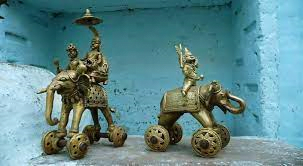Iron-craft, also known as Dokra, stands as a testament to the rich cultural and artistic heritage of India. Dating back more than 4000 years, this metal casting art has evolved into a beautiful expression of tribal creativity and craftsmanship. Originating from the nomadic craftsmen who traveled from tribe to tribe, iron-craft has become synonymous with exquisitely shaped and decorated brassware products created through the lost wax process.
Historical Roots
The roots of iron-craft can be traced to the tribal communities of Madhya Pradesh, where craftsmen went from one tribe to another, crafting ceremonial and religious figures, as well as ornate kitchenware. The iron-craft tradition is a fascinating blend of genuine preservation and the passing down of ancestral knowledge. Today, these skilled artisans, known as karamkars, continue to practice this ancient craft, creating intricate and ethereal pieces.
Geographical Presence
Madhya Pradesh, Chhattisgarh, Orissa, West Bengal, and Andhra Pradesh stand as the primary strongholds of iron-craft in India. Each region contributes its unique flair to this tribal art form. While Madhya Pradesh is renowned for its imaginative wire metalwork, West Bengal boasts the famous Dokra metal craft, producing statues, jewelry, idols, and other decorative pieces using clay, wax, and metal.
Crafting Process
The heart of iron-craft lies in the lost wax technique, a meticulous process involving twelve stages of preparation. Craftsmen use threads made of beeswax to create intricate designs on a clay core, forming a replica of the desired product. The wax mold is then covered with a layer of clay, and the metal is melted to fill the mold. Once the metal cools, the clay is broken, revealing the finished metal object, which is then smoothened and polished to perfection.
Artistic Expression
Iron-craft is not merely a utilitarian art form; it is a celebration of tribal aesthetics and folk essence. The craftsmen create a wide array of figures, including birds, animals, and traditional Santhal jewels. Lamp holders, lamps, chains, vases, and stands are also part of the repertoire, showcasing the versatility of this ancient craft. The art’s rustic and antique finish, achieved through the lost wax process, adds a unique and appealing charm to each piece.
Regional Variations
While Madhya Pradesh serves as the cradle of iron-craft, West Bengal, Bihar, and Orissa have their distant cousins practicing similar crafts. The Ghawa or iron-craft kumar tribes in West Bengal are known for their traditional metalwork. In West Bengal, districts like Bankura, Purulia, Midnapore, and Burdwan are hubs where Dokra art flourishes, thanks to skilled artisans known as Dokra Kamars.
Iron-craft, with its deep historical roots and geographical diversity, continues to captivate art enthusiasts worldwide. Whether it’s the tribal areas of Madhya Pradesh or the districts of West Bengal, the lost wax process brings to life the intricate and enchanting folk motifs of this ancient craft. The legacy of iron-craft is a testament to the enduring creativity and cultural richness of India’s tribal communities.


